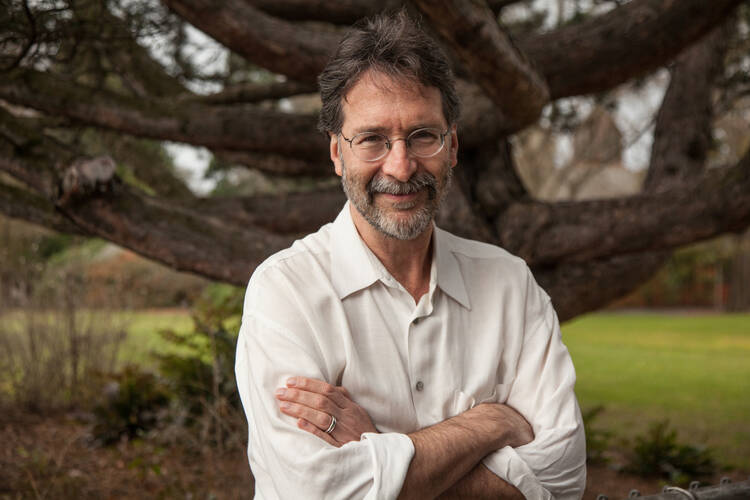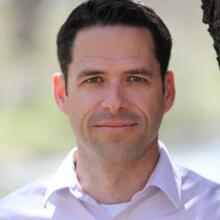In the first sentence of Brian Doyle’s frequently anthologized essay, “Joyas Voladoras,” Doyle asks the reader to “Consider the hummingbird for a long moment.” In a time when so much pessimism permeates the publishing industry, I propose that we consider Brian Doyle’s success and his influence on the landscape of American letters—for much longer than a moment.
Though Doyle died of brain cancer on May 27 at age 60, he left behind a shelf-full of books and dozens of essays. His prose will remain contemporary for many more years. What will his lasting legacy be? Will critics discuss his work a century from now? And when will his work be more fully regarded in our time? Perhaps those who have read him for so long have taken him for granted. Perhaps we have grown too accustomed to reading his books and encountering his essays, seemingly all over the place. Has his ubiquity spoiled us?
His honors include the American Academy of Arts and Letters Award in Literature, a Catholic Book Award, three Pushcart Prizes and Foreward Reviews’ Novel of the Year award in 2011. Doyle earned the 2017 John Burroughs Medal for Distinguished Nature Writing for his novel Martin Marten. He wrote the short story collections Bin Laden’s Bald Spot and The Mighty Currawongs, the novella Cat’s Foot and the novels Mink River, The Plover and Chicago.
Since 1991 Doyle was the editor of Portland Magazine, the well-regarded alumni publication for the University of Portland, where he received an honorary doctorate this spring. He also made the final selections and introductions to the volumes of The Best Catholic Writing of the Year from 2004 to 2007.
I am having a hard time realizing that somewhere in Portland, Doyle is not writing any more sentences that swing and sing and bounce along the page with rollicking musicality.
One fall morning in October of 2010, I heard Brian Doyle read from his essay “Playfulnessness: A Note” at Fordham University, where he said the essay genre “is the most playful and coolest form because it is the most naked.” He paced back and forth before us, looking up from his pages, saying, “The essay is the form with the most pop and verve and connective electricity.”
I am having a hard time realizing that somewhere in Portland, Ore., Doyle is not writing any more sentences that swing and sing and bounce along the page with rollicking musicality. “I get teased a lot for my style,” Doyle told Oregon Public Broadcasting in 2015. “People are saying, wow, a sentence will start on Tuesday and it doesn’t end ’til Friday. But I want to write like people talk. I want to write like I’m speaking to you,” he said.
“Joyas Voladoras” first appeared in The American Scholar in 2004. It was later reprinted in both the Pushcart anthology for that year and The Best American Essays. In all, Brian Doyle’s essays have been selected to be reprinted in The Best American Essays series seven times. Are there any other American Catholic writers who have been more prolific in both secular and Christian publications? If that sounds hyperbolic, consider his production in terms of papal service. During Benedict XVI’s papacy, Doyle published five books. Since Pope Francis has been in Rome, Doyle has published 14 more.
For much longer than a moment, let us consider Doyle’s literary generosity. Other contemporary writers who are Catholic, like Annie Dillard, Alice McDermott and Tobias Wolff, have garnered more fame. Wendell Berry has published more books. The best-selling memoirist and award-winning poet Mary Karr, who writes about her conversion to Catholicism in Lit: A Memoir, has received more acclaim. But I cannot think of any other contemporary American Catholic writers who have published as many books about spiritual matters as Doyle while also being a frequent contributor to some of the country’s most esteemed secular literary journals and magazines, including Creative Nonfiction, Orion, The American Scholar and The Sun. And he regularly appeared in Christian magazines, as well, like this one, America, writing about his faith without apology.
After Oregon State University Press published a new edition of Doyle’s Wet Engine: Exploring the Mad Wild Miracle of the Heart in 2012, the Iowa Review called him “a writer’s writer, unknown to the best-seller or even the good-seller lists, a Townes Van Zandt of essayists, known by those in the know,” proclaiming a “new Brian Doyle essay is a mini-event, the first name you turn to in the table of contents, the first click on a literary web site.”
Doyle wrote shamelessly about Catholic customs, beliefs, practices and mysteries.
Maybe Doyle hasn’t been placed at the same table as Wolff, Karr and McDermott because many of his earlier works were released by independent presses. Maybe some looked down on Doyle’s fascination with Catholicism. Whatever the case may be, Macmillan published his last four novels, including his most recent, The Adventures of John Carson in Several Quarters of the World,anhomagetotheworkofRobertLouisStevenson. The New York Times reviewed it in April of this year. The reviewer’s analysis echoed a sentiment that some readers share about Doyle’s work in general, namely, that it can be “a matter of individual taste,” that either you admire his prose or find it “flirts with excess in ways that can seem annoying or self-indulgent.” The reviewer was ultimately “won over despite myself by his loving reconstruction of an era of storytelling now lost.”
We can consider Doyle an American Catholic writer because he practiced the religion and published about it, but, more important, he wrote shamelessly about Catholic customs, beliefs, practices and mysteries, partially because it’s “illogical, unreasonable, unthinkable, unprovable, nonsensical, counter-cultural, and in direct defiance of all evidence and human history. Isn’t that great?” he wrote in the prologue for his essay collection Grace Notes.
“To grow up Catholic is to be especially lucky as an artist,” he told Nick Ripatrazone in an interview, “because you are soaked in miracle and mystery and symbol and smoke and the confident assertion that every moment is pregnant with miracle and possibility and stuffed with holiness like a turducken.”
Let us consider for much longer than a moment that part of Doyle’s generosity consists of his courageous willingness to search for enduring truths in the attacks of Sept. 11, 2001, in the Sandy Hook elementary school murders and in cancer. “Stories are prayers of terrific power,” he wrote in response to a fan letter from an 11-year-old in Korea. If you have never read his essay “Leap,” go find it online and marvel. Listen to how this prayer begins: “A couple leaped from the south tower, hand in hand. They reached for each other and their hands met and they jumped.” He continued:
Their hands reaching and joining are the most powerful prayer I can imagine, the most eloquent, the most graceful. It is everything that we are capable of against horror and loss and death. It is what makes me believe that we are not craven fools and charlatans to believe in God, to believe that human beings have greatness and holiness within them like seeds that open only under great fires, to believe that some unimaginable essence of who we are persists past the dissolution of what we were, to believe against such evil hourly evidence that love is why we are here.
If you haven’t already done so, go read “His Last Game,” about watching pick-up basketball with his terminally-ill brother in the car, and think about how Doyle crafted the essay without a whiff of sentimentality. Or read “Dawn and Mary,” about the two women at Sandy Hook who “leapt out of their chairs and they ran right at the boy with the rifle” to defend children.
In his essay “On ‘Not’ Beating Cancer” he declares, “Cancer is to be endured, that’s all.” He implores readers: “Use real words. Real words matter. False words are lies. Lies sooner or later are crimes against the body or the soul. I know men, women and children who have cancer, had cancer, died from cancer, lived after their cancer retreated, and not one of them ever used military or sporting metaphors that I remember.”
My admiration for Doyle’s work is not puffed-up, feigned applause for the posthumous author who died too young. I admire how he wrote about his faith with humility and humor. I admire his devotion to his writing vocation—not writing that is devotional, but essays and stories where the insights, scenes, climaxes and larger, more universal significance are not dependent on a readers’ religious beliefs. You do not generate quality work like Doyle’s without minding your craft, without applying continual energy to the habitual act of writing.
Some may find Doyle’s run-on sentences to be an irritation, but that’s also part of his genius. When we don’t land on the deep breath of a period and instead skip by on another comma, we are looking at a subject with Doyle’s sustained gaze, and eventually he takes us to a fresh metaphor, or an unexpected insight. The memorable last sentence of “Joyas Voladoras” comes to mind:
You can brick up your heart as stout and tight and hard and cold and impregnable as you possibly can and down it comes in an instant, felled by a woman’s second glance, a child’s apple breath, the shatter of glass in the road, the words I have something to tell you, a cat with a broken spine dragging itself into the forest to die, the brush of your mother’s papery ancient hand in the thicket of your hair, the memory of your father’s voice early in the morning echoing from the kitchen where he is making pancakes for his children.
Doyle found ways to write about humanity with punch and vibrant courage and sentences that sometimes lasted for days, but his artistry granted us, his readers, access to the human condition we would not have had without his narrative prayers. He left them for us to read.
This piece, published first on the web, has been updated with material developed for the print version.











The first Brian Doyle work I read was "The Wet Engine". It was so moving a meditation that I offer it to retreatants. Rejoice in eternity with the Risen Lord, Brian!
Thanks for this tribute to Brian Doyle. Having first encountered the lyricism of his essays long ago, I was delighted to read "Mink River" a few years later, and then "The Plover", and since then, every book I can find with his name on it. "The Kind of Brave You Wanted to Be ... Prose Prayers and Cheerful Chants against the Dark", published by Liturgical Press, 2016, is another lovely gift. Indeed, he has left us with many a wonderful prayer and story. Peace and tender thoughts to his family.